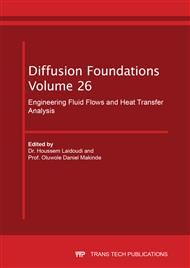p.53
p.63
p.78
p.86
p.104
p.112
p.126
p.145
p.157
Forced Convection Heat Transfer from a Pair of Circular Cylinders Confined in Ventilated Enclosure
Abstract:
This paper deals with a numerical simulation of laminar forced convection heat transfer from a pair of identical circular cylinders placed at the center of square cavity in the line array, the cavity is ventilated with single inlet and outlet ports, the inlet port is located at the middle of left vertical wall and the outlet port is located at the middle of right vertical wall. The work represents the effects of the distance between cylinders and Reynolds number on fluid flow and heat transfer rate. The governing equations of continuity, momentum and energy are solved by using finite-volume method. The obtained results are represented and discussed for following conditions: Reynolds number Re = 1 to 40, Prandtl number Pr = 7.01 and the gap distance S = 0.3L to 0.7L, where L is the cavity length. The main results are potted under the streamline and isotherm contours, the total drag coefficient and average Nusselt number of each cylinder is plotted versus studied parameters. It is found that the increase in the gap space distance between cylinders increases the heat transfer rate.
Info:
Periodical:
Pages:
104-111
Citation:
Online since:
March 2020
Keywords:
Price:
Сopyright:
© 2020 Trans Tech Publications Ltd. All Rights Reserved
Share:
Citation:


